Study of Low-Temperature Energy Consumption Optimization of Battery Electric Vehicle Air Conditioning Systems Considering Blower Efficiency
Abstract
:1. Introduction
- The total energy consumption of the air conditioning system of BEVs was theoretically calculated and analyzed.
- The vehicle test, blower performance test, and component performance test were carried out, and the relevant data were analyzed to determine the benchmark working condition of the three-dimensional numerical simulation.
- The three-dimensional numerical model of the passenger compartment and air conditioning system was established, and the influence of PTC power and airflow rate on the average temperature of the measurement points was analyzed. The isotherm diagram of the average temperature concerning PTC power and airflow rate was obtained. On this basis, the alternative working conditions that meet the temperature requirement were determined.
- The optimization study was carried out on the alternative working conditions. Compared with the benchmark working condition, the theoretical total power of the optimized scheme was reduced by 68.49 W, and the actual total power was reduced by 23.49 W. The results show that the optimization of the total power consumption of the air conditioning system should comprehensively consider PTC power, airflow rate, and blower efficiency.
- The optimized scheme was tested to verify the reliability of the research method, and a general method for optimizing the low-temperature energy consumption of the air conditioning system of BEVs was summarized and proposed. This method can be used as a guide for the selection of blowers and the development of control strategies for the air conditioning system.
2. Materials and Methods
2.1. Theoretical Analysis of Total Energy Consumption
2.2. Experimental Research
2.2.1. The Vehicle Test
2.2.2. The Blower Performance Test
2.2.3. The Component Performance Test
2.2.4. The Vehicle Test Results and Analysis
2.3. Three-Dimensional Numerical Model
2.3.1. Establishment and Verification of the Three-Dimensional Numerical Model
2.3.2. Using the Numerical Model to Study the Influence of PTC Power and Airflow Rate on Temperature
3. Results and Discussion
3.1. Analysis of the Influence of PTC Power and Airflow Rate on Temperature and Determination of Alternative Working Conditions
3.1.1. Analysis of Different Airflow Rates with the Same PTC Power
3.1.2. Analysis of Different PTC Powers with the Same Airflow Rate
3.1.3. Determination of the Alternative Working Conditions
3.2. Optimization and Discussion of the Low-Temperature Energy Consumption of the Air Conditioning System
3.2.1. Optimization of the Theoretical Total Power of the Air Conditioning System
3.2.2. Optimization of the Actual Total Power of the Air Conditioning System Considering the Blower Efficiency
3.2.3. Experimental Verification of the Optimization Result
3.3. Summary of General Optimization Method for Low-Temperature Energy Consumption of BEV Air Conditioning Systems
- Determine the benchmark working conditions under the target boundary conditions through the vehicle test, and obtain the efficiency characteristic of the blower through the blower performance test as the basis of numerical simulation;
- Clarify the influence of PTC power and airflow rate on the measurement point temperature through numerical simulation and obtain the isotherm diagram of the measurement point temperature versus PTC power and airflow rate;
- Determine the alternative working conditions based on the isotherm diagram and the target measurement point temperature. Run simulations to verify the measurement point temperature and obtain the pressure drop corresponding to each operating condition;
- Calculate the actual total power of the air conditioning system corresponding to the alternative operating conditions based on the efficiency of the blower, and select the optimal working condition;
- When there are multiple blowers as alternatives, this method can guide the comparative selection of blowers. When selecting, the optimal working condition of each blower should be obtained first, and then the blower that makes the actual total power consumption of the air conditioning system smaller should be selected. When the boundary conditions are changed or there are multiple boundary conditions, the total power consumption of the selected blower should be minimized under the commonly used conditions;
- After the blower is selected or given, this method can guide the determination of the control strategies of the air conditioning system. The optimal working conditions for the actual total power consumption of the air conditioning system under various boundary conditions should be obtained first, and control strategies should be formulated to try to make the air conditioning system operate under the optimal working conditions under each boundary condition.
4. Conclusions
- The concept of the total power consumption of the air conditioning systems at low temperatures was proposed as an evaluation indicator. The efficiency characteristic of the blower and the benchmark working condition of the three-dimensional numerical simulation can be obtained through experiments, and the test results can be used as the basis for the establishment and verification of the numerical model.
- The numerical model can be used to study the influence of PTC power and airflow rate on the temperatures of the measuring points. When the PTC power is the same, the temperature gradually increases in general as the airflow rate increases; when the airflow rate is the same, the temperature also increases as the PTC power increases. The isotherm diagram obtained based on the simulation results can be used to determine alternative working conditions for optimization. The theoretical total power of the optimized scheme is reduced by 68.49 W, and the actual total power is reduced by 23.49 W. The optimization of the actual total power needs to comprehensively consider the influence of PTC power, airflow rate, and blower efficiency.
- The general low-temperature energy consumption optimization method of BEV air conditioning systems proposed in this research can improve energy efficiency and drive range. It also has an instructive role in the selection of blowers and the development of control strategies.
Author Contributions
Funding
Data Availability Statement
Acknowledgments
Conflicts of Interest
References
- Thakur, A.K.; Sathyamurthy, R.; Velraj, R.; Saidur, R.; Pandey, A.K.; Ma, Z.; Singh, P.; Hazra, S.K.; Sharshir, S.W.; Prabakaran, R.; et al. A state-of-the art review on advancing battery thermal management systems for fast-charging. Appl. Therm. Eng. 2023, 226, 120303. [Google Scholar] [CrossRef]
- Kumar, R.R.; Alok, K. Adoption of electric vehicle: A literature review and prospects for sustainability. J. Clean Prod. 2020, 253, 119911. [Google Scholar] [CrossRef]
- Jiang, F.; Yuan, X.H.; Hu, L.L.; Xie, G.M.; Zhang, Z.Q.; Li, X.P.; Hu, J.; Wang, C.; Wang, H.C. A comprehensive review of energy storage technology development and application for pure electric vehicles. J. Energy Storage 2024, 86, 111159. [Google Scholar] [CrossRef]
- Li, Z.H.; Khajepour, A.; Song, J.C. A comprehensive review of the key technologies for pure electric vehicles. Energy 2019, 182, 824–839. [Google Scholar] [CrossRef]
- Andwari, A.M.; Pesiridis, A.; Rajoo, S.; Martinez-Botas, R.; Esfahanian, V. A review of Battery Electric Vehicle technology and readiness levels. Renew. Sust. Energ. Rev. 2017, 78, 414–430. [Google Scholar] [CrossRef]
- Jones, N. The new car batteries that could power the electric vehicle revolution. Nature 2024, 626, 248–251. [Google Scholar] [CrossRef]
- Zhou, W.B.; Cleaver, C.J.; Dunant, C.F.; Allwood, J.M.; Lin, J.G. Cost, range anxiety and future electricity supply: A review of how today?s technology trends may influence the future uptake of BEVs. Renew. Sust. Energ. Rev. 2023, 173, 113074. [Google Scholar] [CrossRef]
- Rauh, N.; Franke, T.; Krems, J.F. Understanding the Impact of Electric Vehicle Driving Experience on Range Anxiety. Hum. Factors 2015, 57, 177–187. [Google Scholar] [CrossRef]
- Yang, D.X.; Liu, H.; Li, M.H.; Xu, H. Data-driven analysis of battery electric vehicle energy consumption under real-world temperature conditions. J. Energy Storage 2023, 72, 108590. [Google Scholar] [CrossRef]
- Zhao, C.; Li, Y.C.; Yang, Y.; Wan, S.; Yu, F.Y.; Yu, C.; Deng, C.H.; Zhou, A.J.; Shen, X.Y. Research on electric vehicle range under cold condition. Adv. Mech. Eng. 2022, 14, 16878132221087083. [Google Scholar] [CrossRef]
- Meyer, J.J.; Lustbader, J.; Agathocleous, N.; Vespa, A.; Rugh, J.; Titov, G. Range Extension Opportunities While Heating a Battery Electric Vehicle. In Proceedings of the 2018 SAE World Congress Experience, WCX 2018, Detroit, MI, USA, 10–12 April 2018. [Google Scholar] [CrossRef]
- Qi, Z.G. Advances on air conditioning and heat pump system in electric vehicles—A review. Renew. Sust. Energ. Rev. 2014, 38, 754–764. [Google Scholar] [CrossRef]
- Sun, X.L.; Zhou, F.; Fu, J.Q.; Liu, J.P. Experiment and simulation study on energy flow characteristics of a battery electric vehicle throughout the entire driving range in low-temperature conditions. Energy 2024, 292, 130542. [Google Scholar] [CrossRef]
- Yang, D.Z.; Huo, Y.L.; Zhang, Q.; Xie, J.; Yang, Z.K. Recent advances on air heating system of cabin for pure electric vehicles: A review. Heliyon 2022, 8, e11032. [Google Scholar] [CrossRef]
- Wang, A.C.; Yin, X.; Jia, F.; Cao, F.; Liu, Y.X.; Wang, X.L. Driving range evaluation based on different cabin thermal management goals of CO2 heat pumps for electric vehicles. J. Clean Prod. 2023, 382, 135201. [Google Scholar] [CrossRef]
- Song, J.; Kim, J.; Eom, S.; Lee, J.; Chu, Y.; Kim, J.; Choi, S.; Choi, M.; Choi, G.; Park, Y. Study on the refrigerant interchangeability under extreme operating conditions of R1234yf heat pump systems for electric vehicles. Appl. Therm. Eng. 2024, 245, 122789. [Google Scholar] [CrossRef]
- Tang, B.; Jiang, H.S.; Zhuge, W.L.; Sun, L. Adaptability and environmental impact of CO2/R41 mixture in heat pump air conditioning systems for electric vehicles. Appl. Therm. Eng. 2024, 250, 123463. [Google Scholar] [CrossRef]
- Li, K.; Luo, S.X.; Fan, L.; Hu, S.S.; Zhou, X.J.; Tu, R.; Zhang, H.Q.; Jin, X.T.; Zhao, X.S.; Su, L. Investigation on the performance and characteristics of a heat pump system for electric vehicles under extreme temperature conditions. Case Stud. Therm. Eng. 2021, 27, 101308. [Google Scholar] [CrossRef]
- Lee, S.W.; Chung, Y.; Kim, S.; Jeong, Y.; Kim, M.S. Predictive optimization method for the waste heat recovery strategy in an electric vehicle heat pump system. Appl. Energy 2023, 333, 120572. [Google Scholar] [CrossRef]
- Hong, J.; Song, J.; Han, U.; Kim, H.; Choi, H.; Lee, H. Performance investigation of electric vehicle thermal management system with thermal energy storage and waste heat recovery systems. Etransportation 2024, 20, 100317. [Google Scholar] [CrossRef]
- Zeng, X.; Huang, Y.; Song, D.; Gao, F. Design and Research on the Thermal Management Integrated Control System of BEV Based on Heat Pump Air Conditioner. SAE Int. J. Passeng. Vehicl. Syst. 2022, 15, 91–104. [Google Scholar] [CrossRef]
- Rolando, L.; Millo, F.; Vinogradov, A.; Paradisi, B.P.; Allocco, A.; Ceres, P.; Marco, R.; Rostagno, M.M. A virtual test rig for performance and efficiency assessment of heat pump thermal management system for battery electric vehicles. Appl. Therm. Eng. 2024, 247, 123055. [Google Scholar] [CrossRef]
- Sevilgen, G.; Kiliç, M.; Bayram, H.; Basak, E.; Dursun, H. The investigation of the innovative hybrid heat pump system designed and prototyped for heating process of electric vehicles. Alex. Eng. J. 2023, 68, 417–435. [Google Scholar] [CrossRef]
- Park, M.H.; Kim, S.C. Effects of geometric parameters and operating conditions on the performance of a high-voltage PTC heater for an electric vehicle. Appl. Therm. Eng. 2018, 143, 1023–1033. [Google Scholar] [CrossRef]
- Xia, Y.X.; Feng, G.Z.; Xu, J.J.; Zhu, J.T.; Han, G.; Zhou, W.M.; Xiao, Y.P. Research and optimization of new wavy fin geometry parameters in positive temperature coefficient heaters for electric vehicles. Appl. Therm. Eng. 2023, 222, 119859. [Google Scholar] [CrossRef]
- Shin, Y.H.; Sim, S.; Kim, S.C. Performance Characteristics of a Modularized and Integrated PTC Heating System for an Electric Vehicle. Energies 2016, 9, 18. [Google Scholar] [CrossRef]
- Shin, Y.H.; Ahn, S.K.; Kim, S.C. Performance Characteristics of PTC Elements for an Electric Vehicle Heating System. Energies 2016, 9, 813. [Google Scholar] [CrossRef]
- Nielsen, F.; Uddheim, Å.; Dalenback, J.O. Potential energy consumption reduction of automotive climate control systems. Appl. Therm. Eng. 2016, 106, 381–389. [Google Scholar] [CrossRef]
- Li, K.; Huang, Y.; Li, L.; Dong, D. Global sensitivity analysis of structural parameters for automobile air conditioning blower. In Proceedings of the 1st International Conference on Mechanics, Electronics, Automation and Automatic Control, MEAAC 2023, Hybrid, Wuhan, China, 13–15 May 2023. [Google Scholar] [CrossRef]
- Kamada, M.; Shimoyama, K.; Sato, F.; Washiashi, J.; Konishi, Y. Multi-objective design optimization of a high efficiency and low noise blower unit of a car air-conditioner. Proc. Inst. Mech. Eng. Part D-J. Automob. Eng. 2019, 233, 3493–3503. [Google Scholar] [CrossRef]
- Liang, Y.Q.; Wang, J.B.; Wang, S. Intelligent Control Strategy of Fresh Air Volume in Cabin Under Heating Condition and Evaluation of Its Energy-Saving Effect. J. Therm. Sci. Eng. Appl. 2023, 15, 091009. [Google Scholar] [CrossRef]
- Jose, S.S.; Chidambaram, R.K. Electric Vehicle Air Conditioning System and Its Optimization for Extended Range-A Review. World Electr. Vehicle J. 2022, 13, 204. [Google Scholar] [CrossRef]
- Babu, A.R.; Sebben, S.; Chronéer, Z.; Etemad, S. An adaptive cabin air recirculation strategy for an electric truck using a coupled CFD-thermoregulation approach. Int. J. Heat Mass Transf. 2024, 221, 125056. [Google Scholar] [CrossRef]
- Oh, M.S.; Ahn, J.H.; Kim, D.W.; Fang, D.S.; Kim, Y. Thermal comfort and energy saving in a vehicle compartment using a localized air-conditioning system. Appl. Energy 2014, 133, 14–21. [Google Scholar] [CrossRef]
- Wu, J.; Liu, J.; Zhao, J.; Su, Y. Influencing assessment of different heating modes on thermal comfort in electric vehicle cabin. Energy Environ. 2024, 5, 556–567. [Google Scholar] [CrossRef]
- Zhang, S.; Cheng, Y.; Fang, Z.S.; Huan, C.; Lin, Z. Optimization of room air temperature in stratum-ventilated rooms for both thermal comfort and energy saving. Appl. Energy 2017, 204, 420–431. [Google Scholar] [CrossRef]
- Lian, Y.B.; Ling, H.P.; Zhu, J.P.; Lv, J.L.; Xie, Z.W. Thermal management optimization strategy of electric vehicle based on dynamic programming. Control Eng. Pract. 2023, 137, 105562. [Google Scholar] [CrossRef]
- Cvok, I.; Ratkovic, I.; Deur, J. Multi-Objective Optimisation-Based Design of an Electric Vehicle Cabin Heating Control System for Improved Thermal Comfort and Driving Range. Energies 2021, 14, 1203. [Google Scholar] [CrossRef]
- Liu, X.A.; Zhang, F.T.; Zhang, Z.C.; Huang, Y.; Chen, L.; Li, X.Y. A three-heat source segmented heating control strategy based on waste heat recovery technology for electric vehicles. Energy Convers. Manage. 2024, 300, 117932. [Google Scholar] [CrossRef]
- Pan, C.F.; Tao, Y.X.; Wang, L.M.; Li, H.H.; Yang, J.F. Fuzzy energy management strategy for electric vehicle combining driving cycle construction and air-conditioning load identification. Adv. Mech. Eng. 2021, 13, 1687814021994381. [Google Scholar] [CrossRef]
- Li, N.; Xie, K.; Liu, C.X.; Zhou, J.M.; Yin, J.P. New control methodology of electric vehicles energy consumption optimization based on air conditioning thermal comfort. Appl. Therm. Eng. 2024, 241, 122375. [Google Scholar] [CrossRef]
- Tian, Z.; Qian, C.H.; Gu, B.; Yang, L.; Liu, F. Electric vehicle air conditioning system performance prediction based on artificial neural network. Appl. Therm. Eng. 2015, 89, 101–114. [Google Scholar] [CrossRef]
- He, L.E.; Li, P.P.; Zhang, Y.; Jing, H.D.; Gu, Z.H. Intelligent control of electric vehicle air conditioning system based on deep reinforcement learning. Appl. Therm. Eng. 2024, 245, 122817. [Google Scholar] [CrossRef]
- Park, M.H.; Kim, S.C. Heating Performance Characteristics of High-Voltage PTC Heater for an Electric Vehicle. Energies 2017, 10, 1494. [Google Scholar] [CrossRef]
- June, M.S.; Kribs, J.; Lyons, K.M. Measuring efficiency of positive and negative ionic wind devices for comparison to fans and blowers. J. Electrost. 2011, 69, 345–350. [Google Scholar] [CrossRef]
- GB/T 18386.18381-12021; Test Methods for Energy Consumption and Range of Electric Vehicles—Part 1: Light-Duty Vehicles. Standards Press of China: Beijing, China, 2021.
- GB/T 38146.38141-32019; China Automotive Test Cycle—Part 1: Light-Duty Vehicles. Standards Press of China: Beijing, China, 2019.
- Tan, L.B.; Yuan, Y.J. Computational fluid dynamics simulation and performance optimization of an electrical vehicle Air-conditioning system. Alex. Eng. J. 2022, 61, 315–328. [Google Scholar] [CrossRef]
- Forrest, W.O.; Bhatti, M.S. Energy efficient automotive air conditioning system. In Proceedings of the SAE 2002 World Congress, Detroit, MI, USA, 4–7 March 2002. [Google Scholar] [CrossRef]
- Pan, L.Y.; Liu, C.C.; Zhang, Z.Q.; Wang, T.Y.; Shi, J.Y.; Chen, J.P. Energy-saving effect of utilizing recirculated air in electric vehicle air conditioning system. Int. J. Refrig.-Rev. Int. Froid 2019, 102, 122–129. [Google Scholar] [CrossRef]



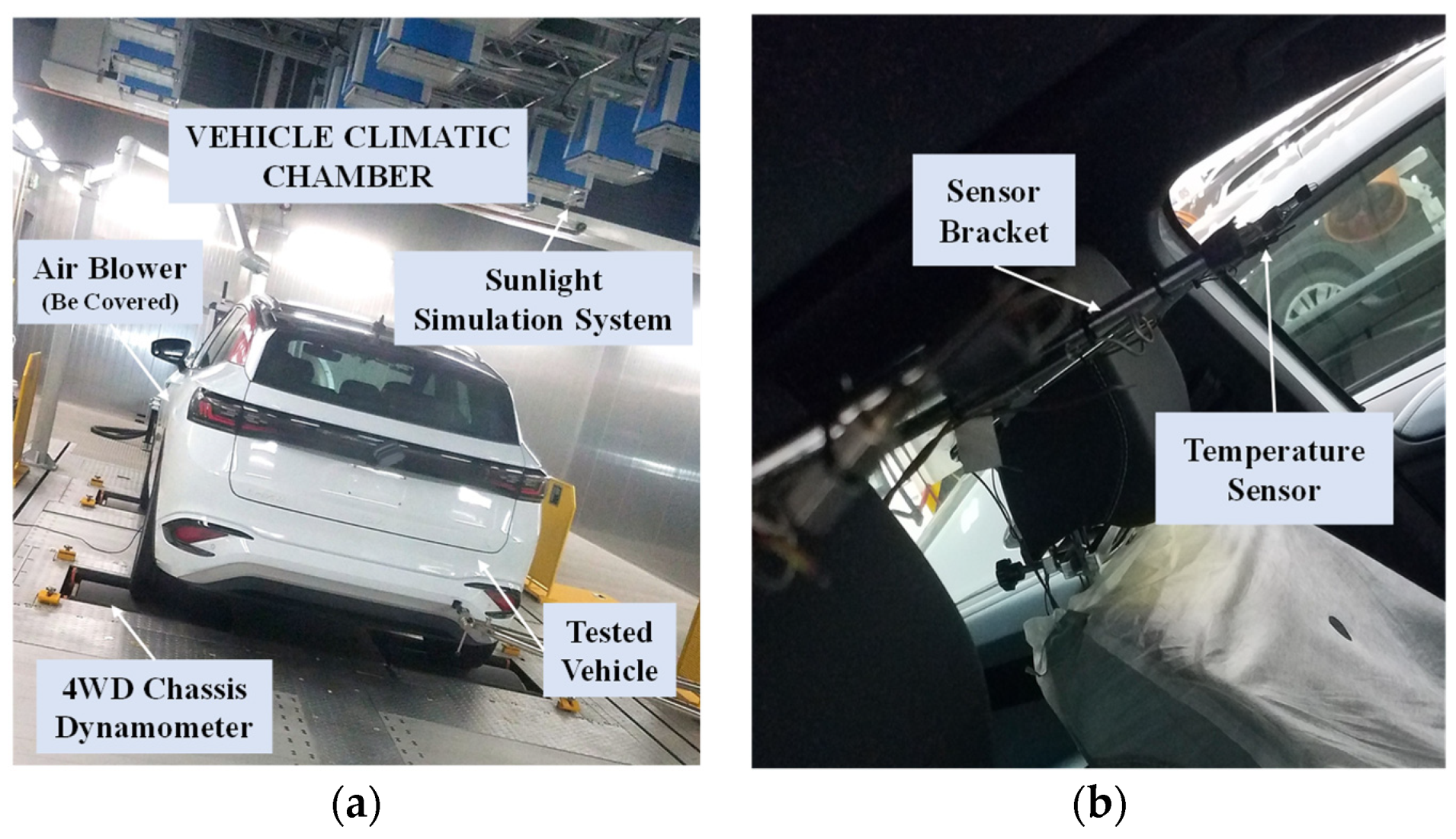
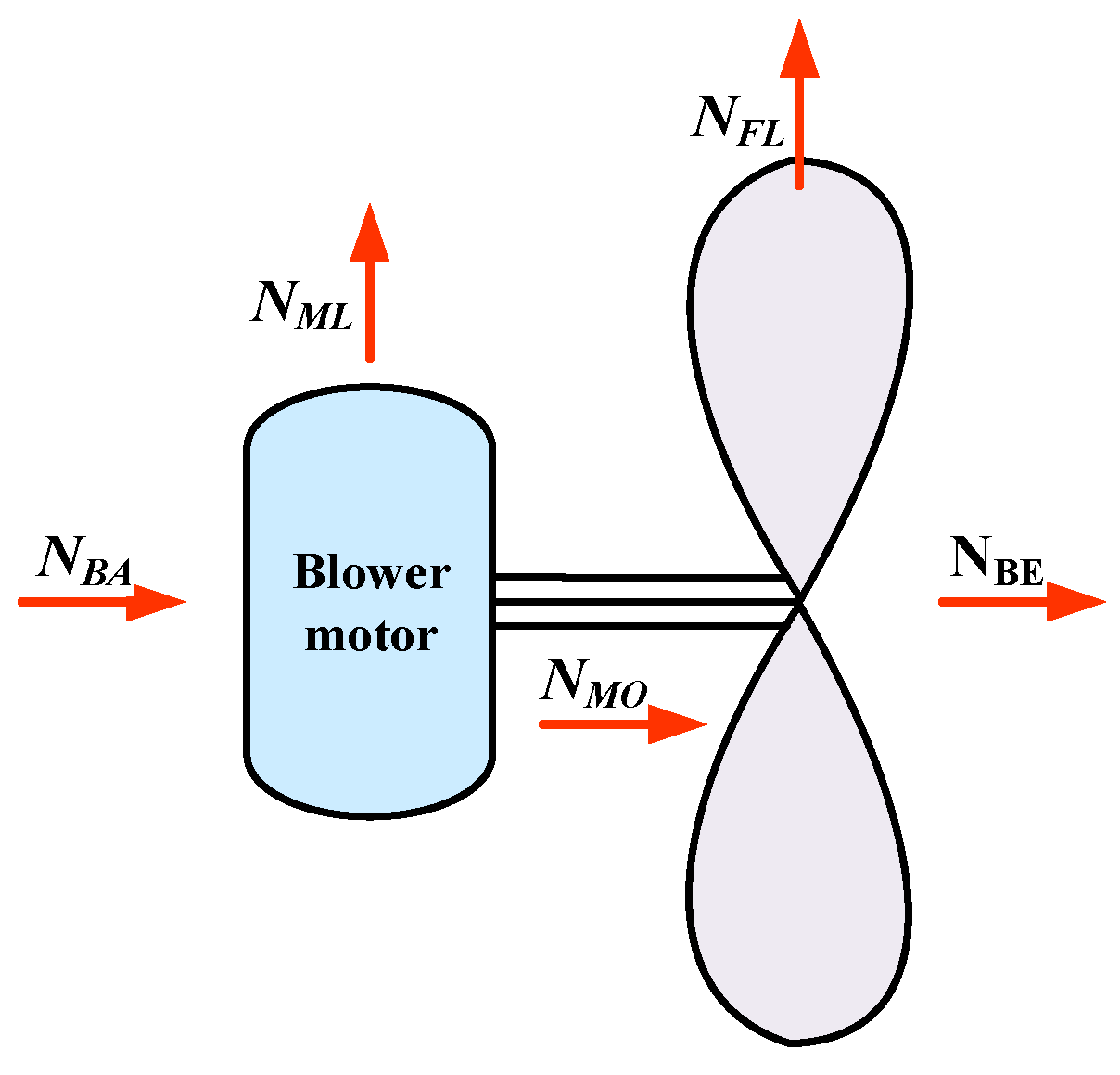
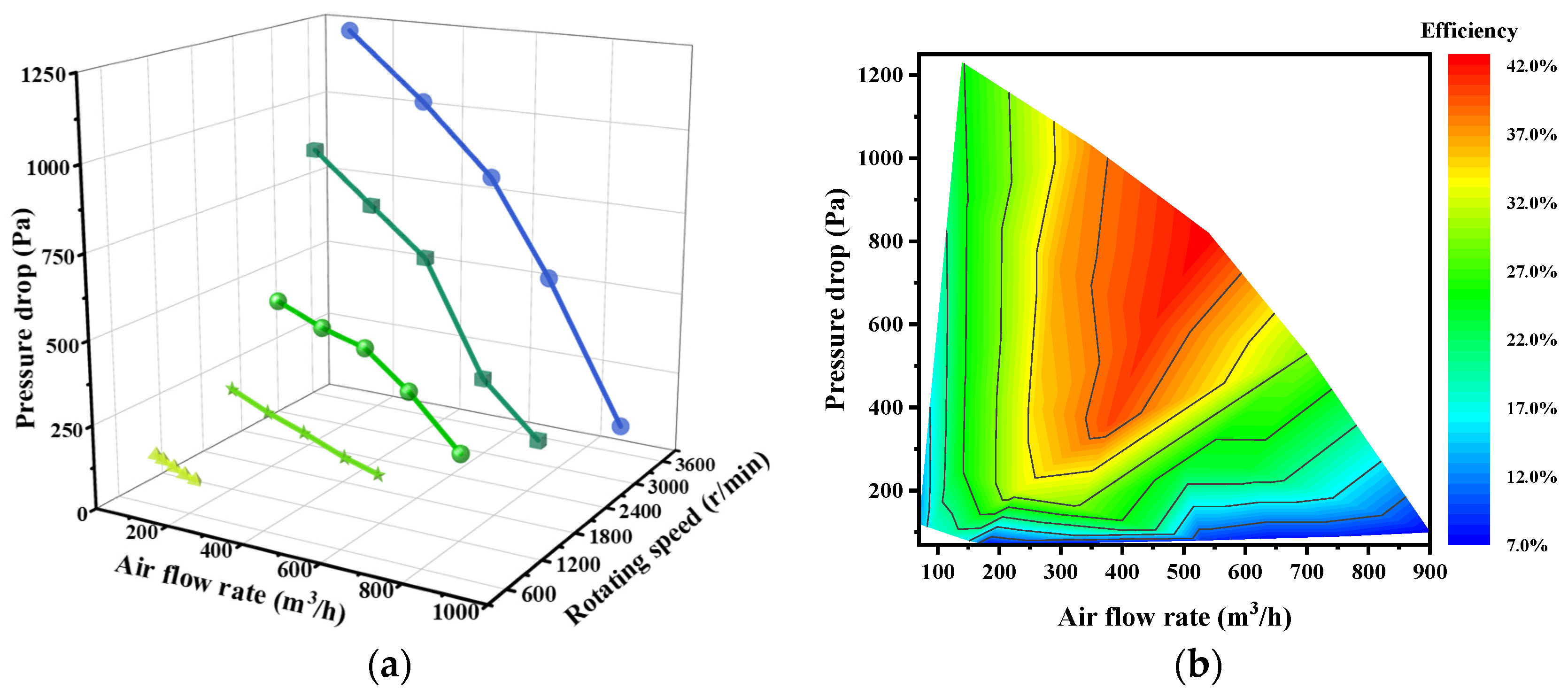
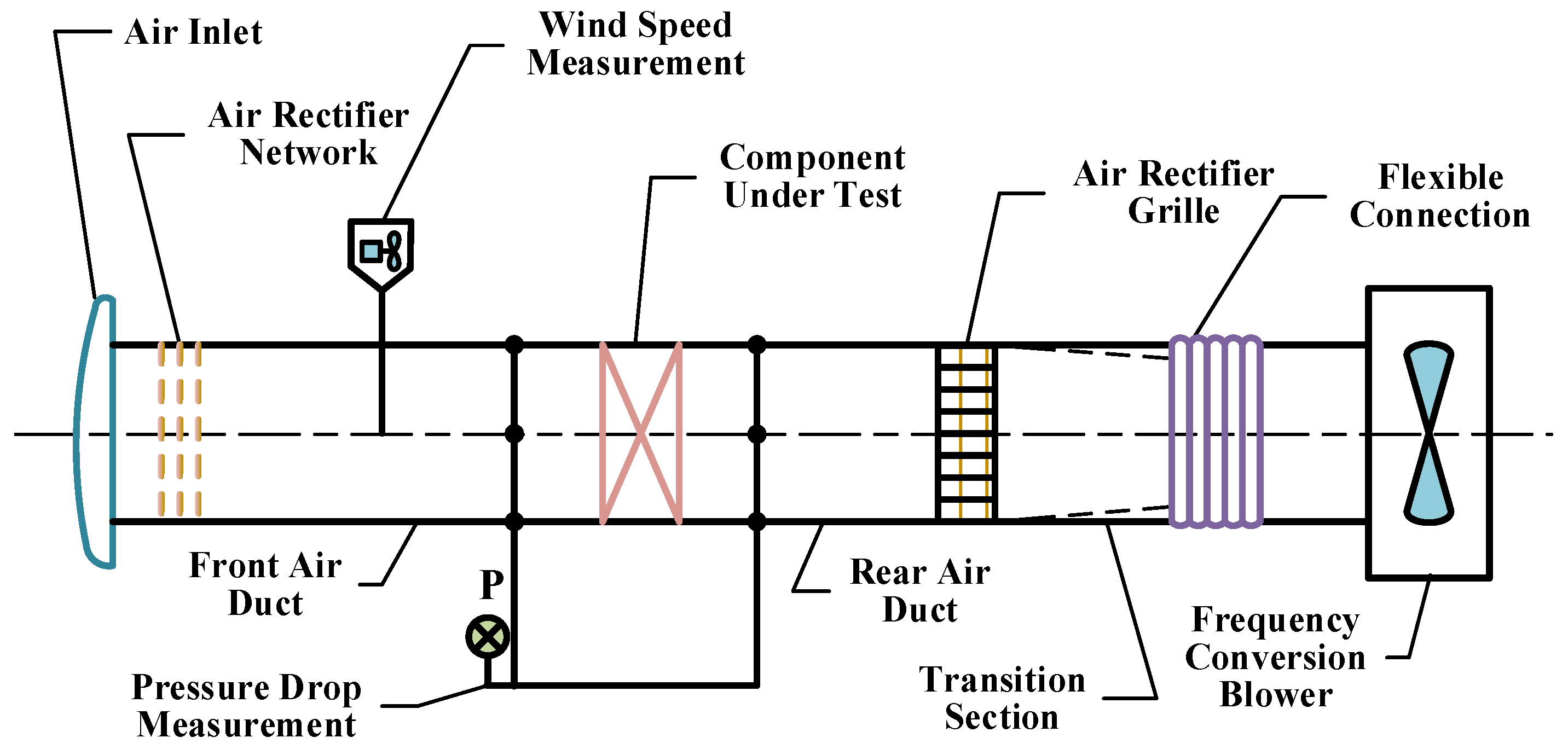
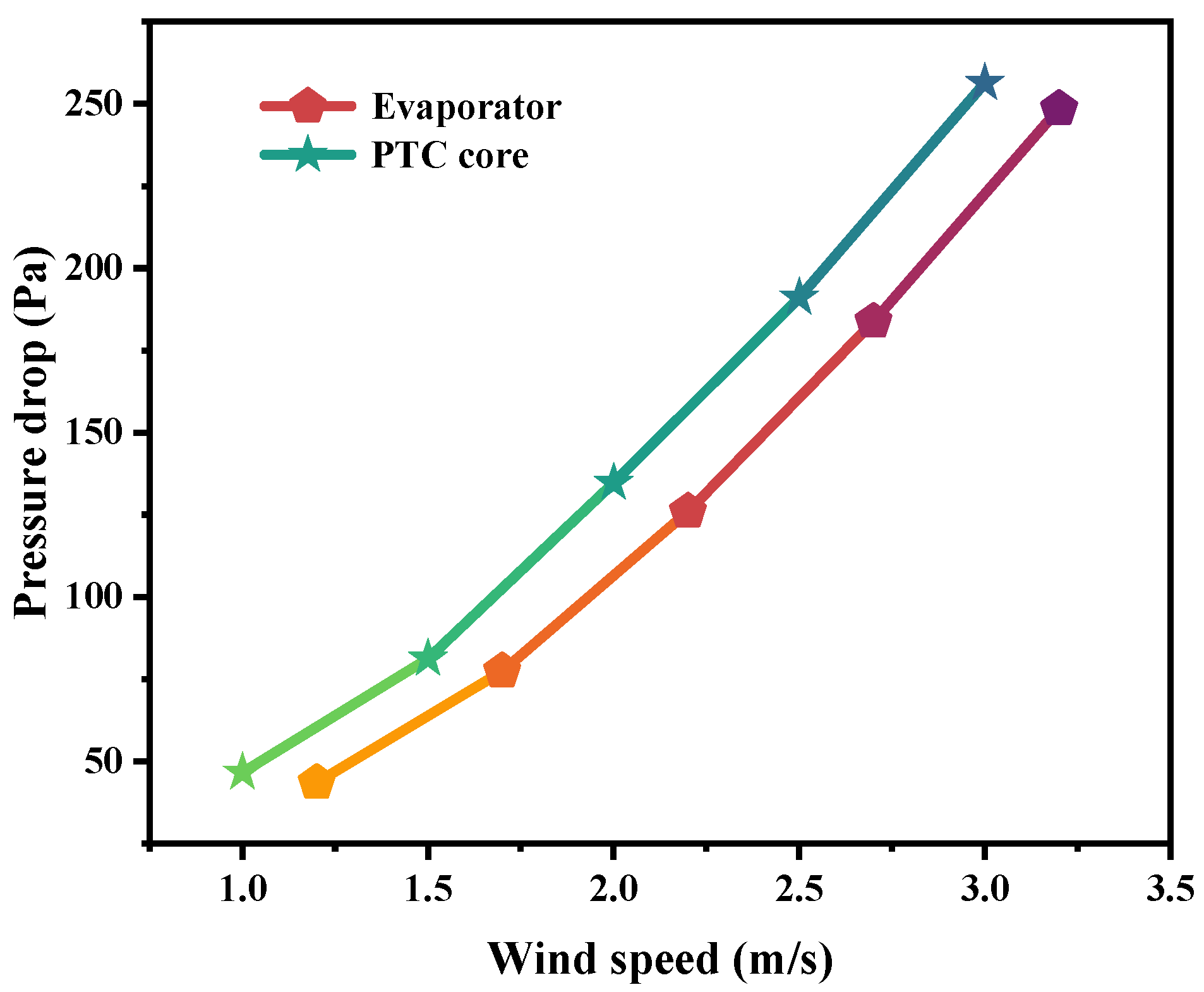
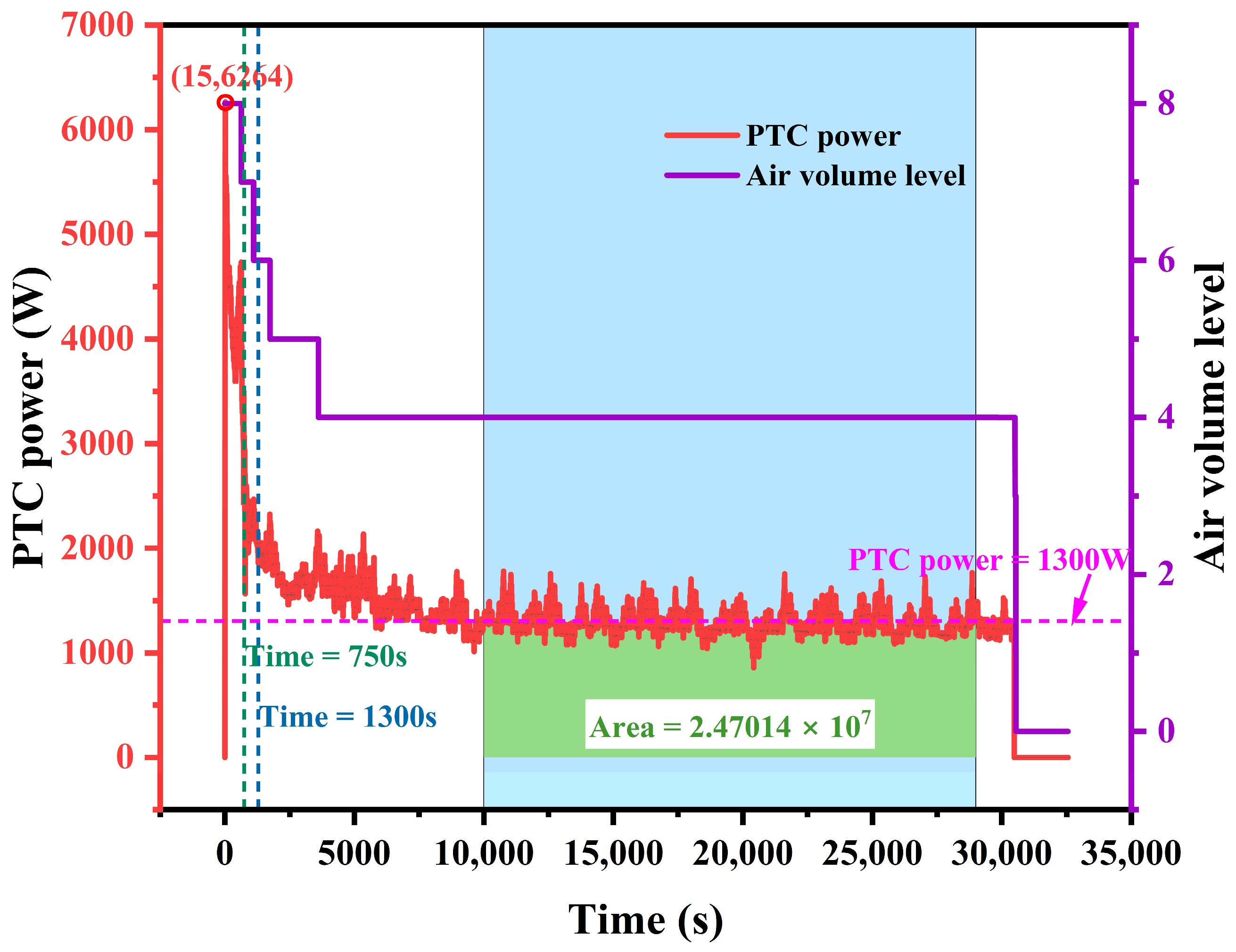
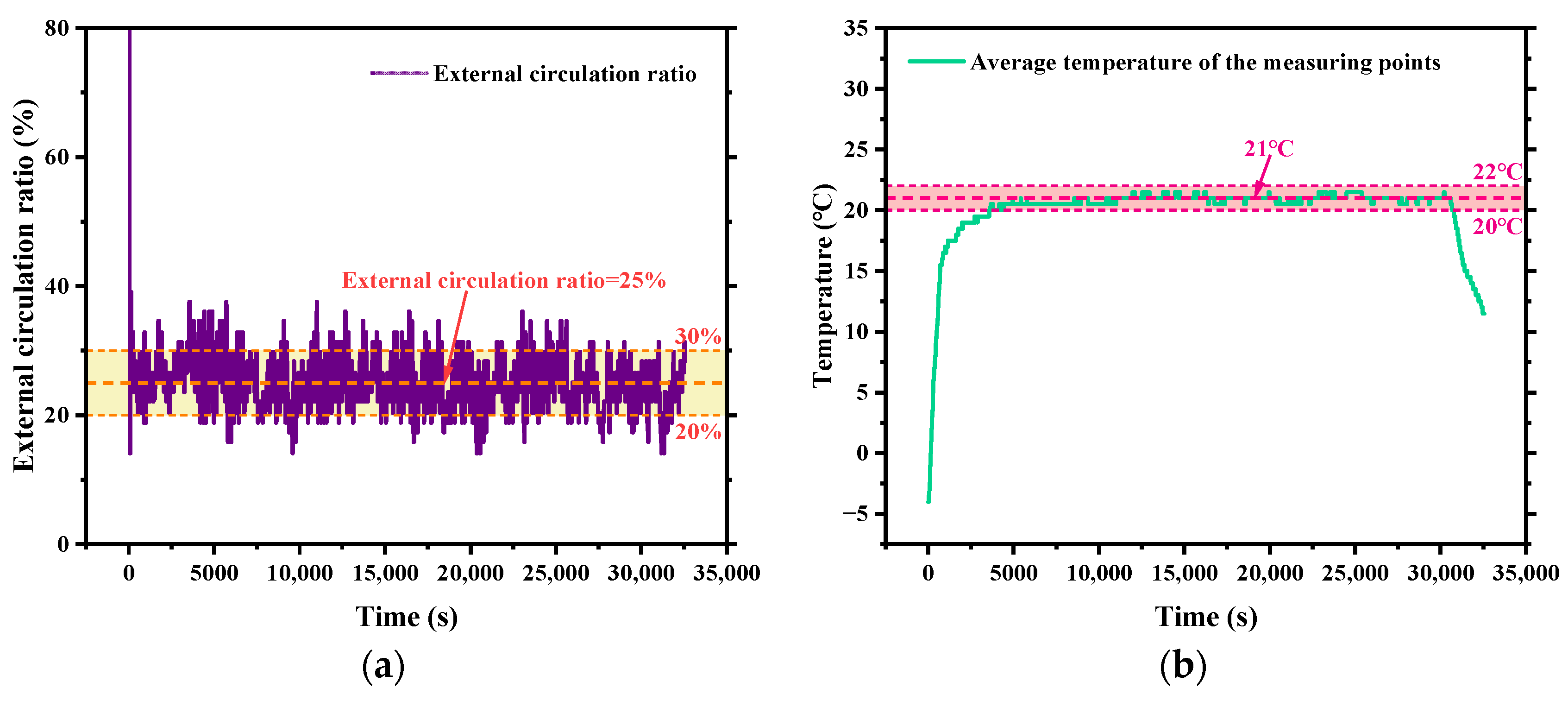

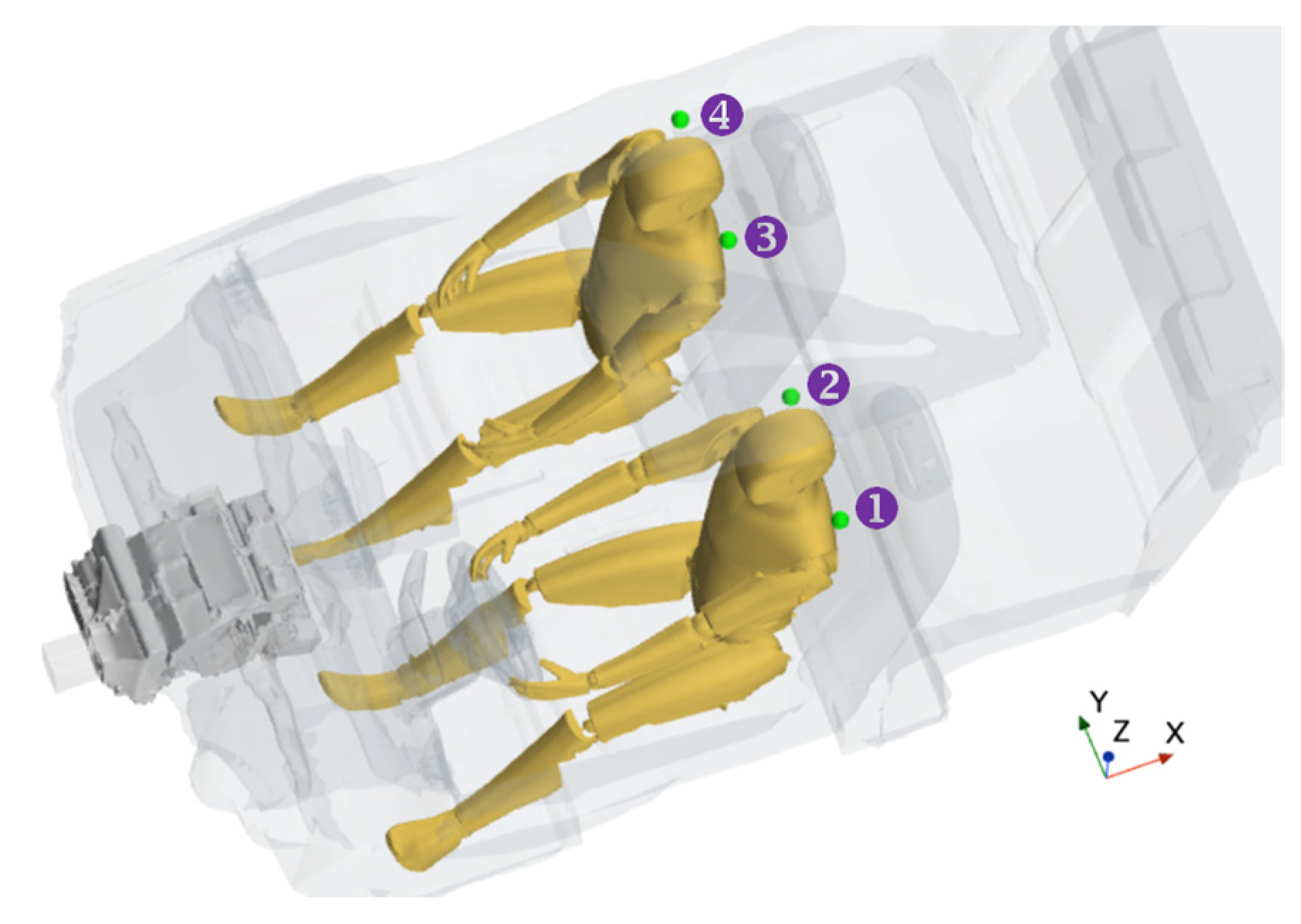
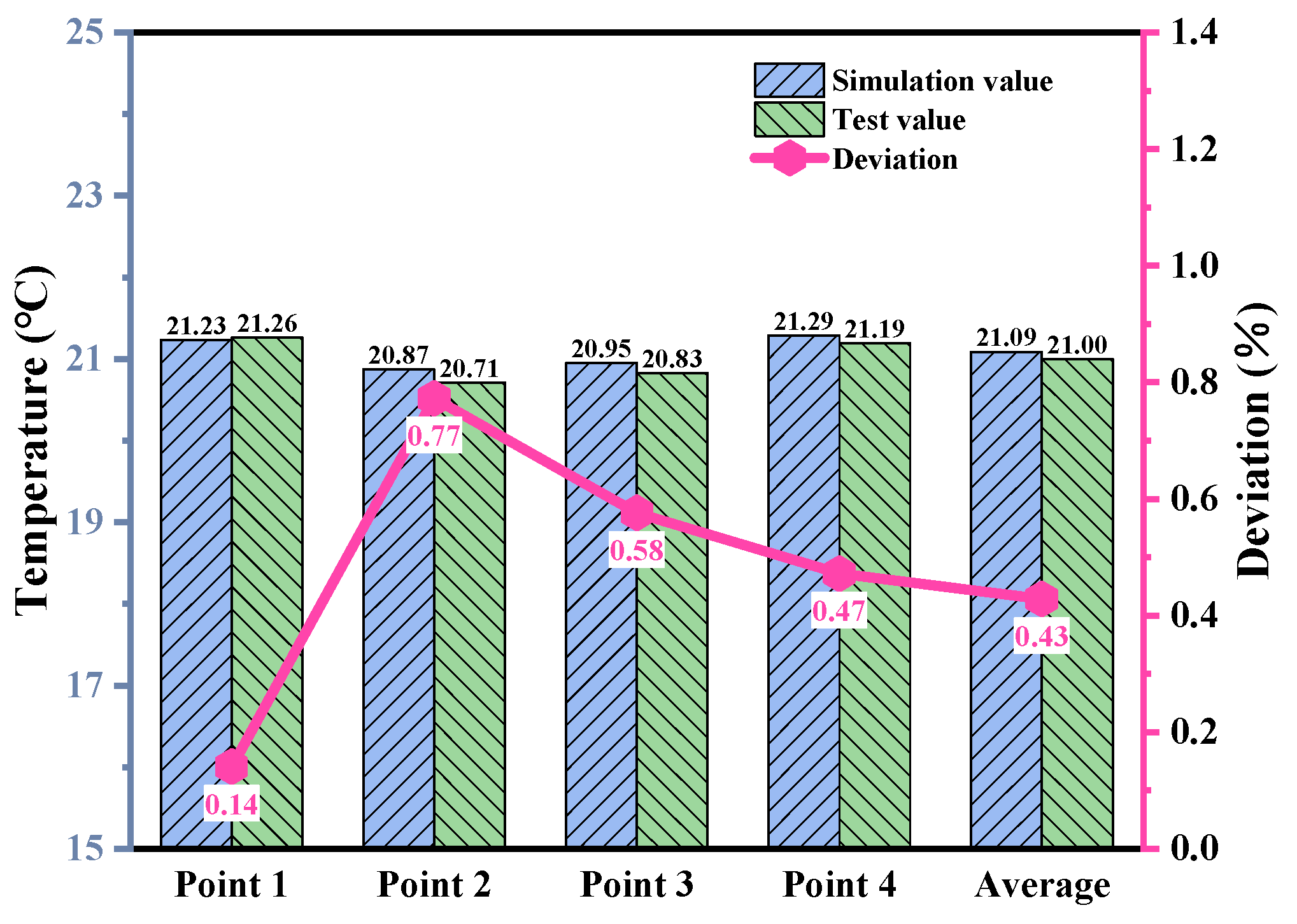
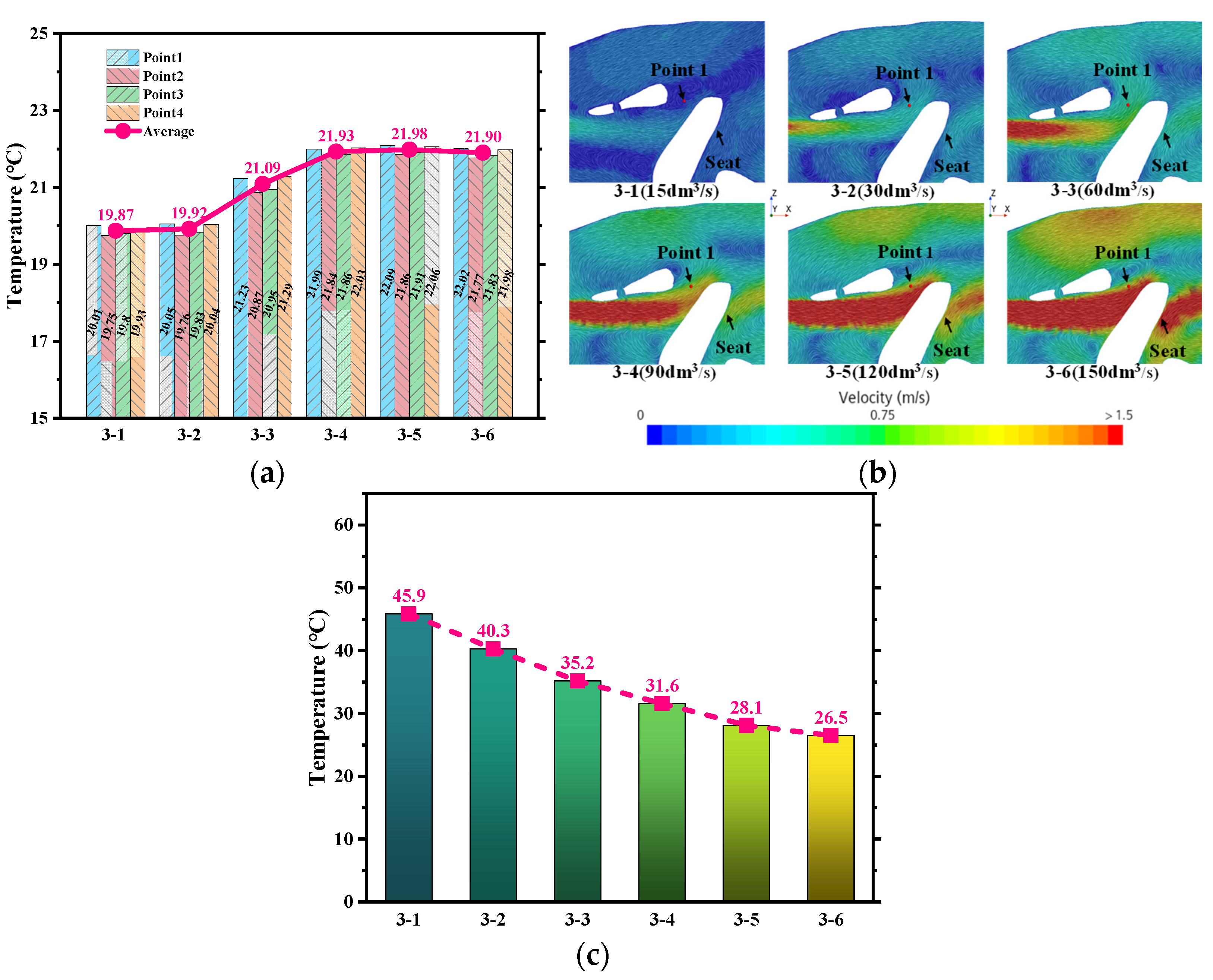
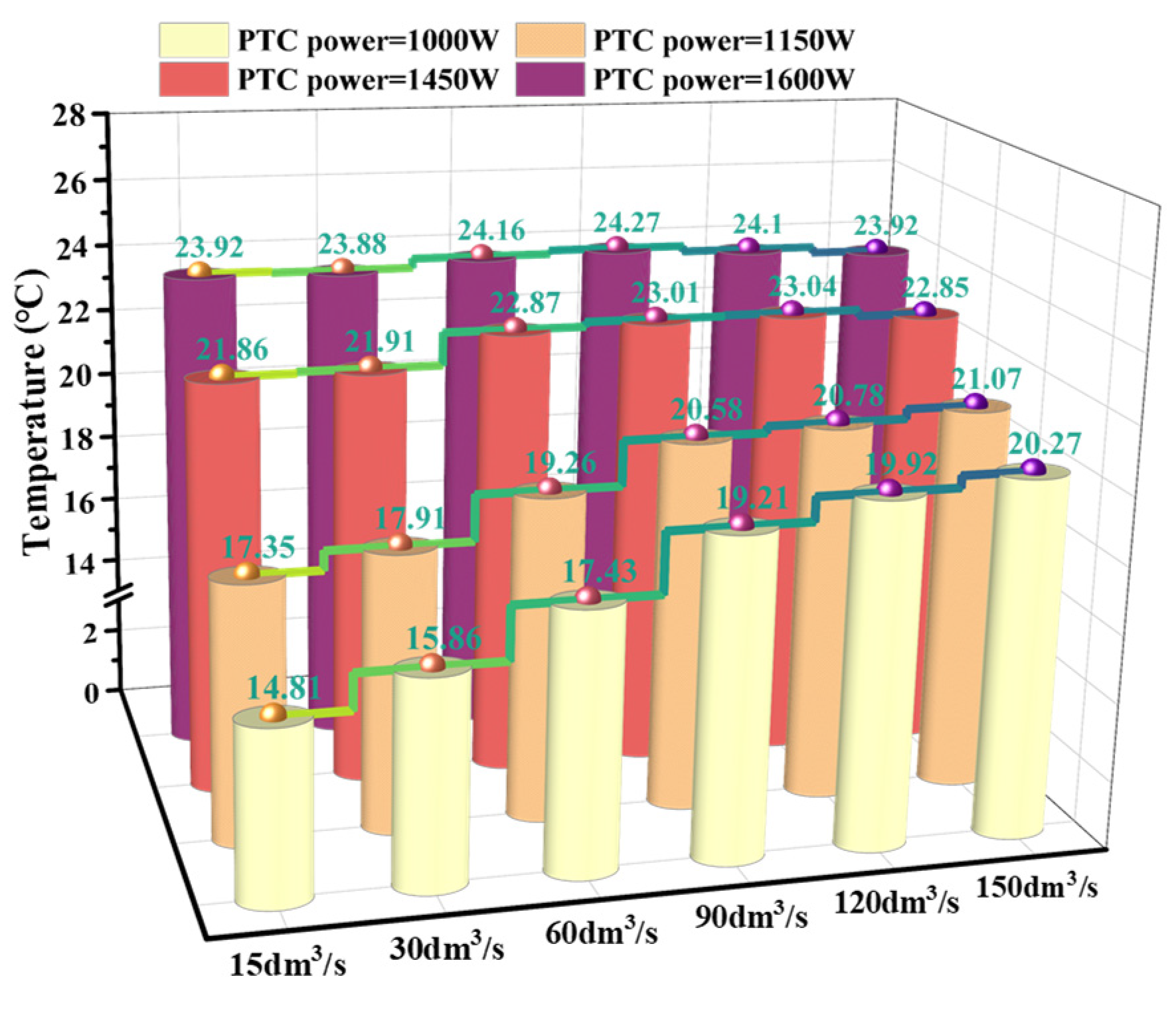

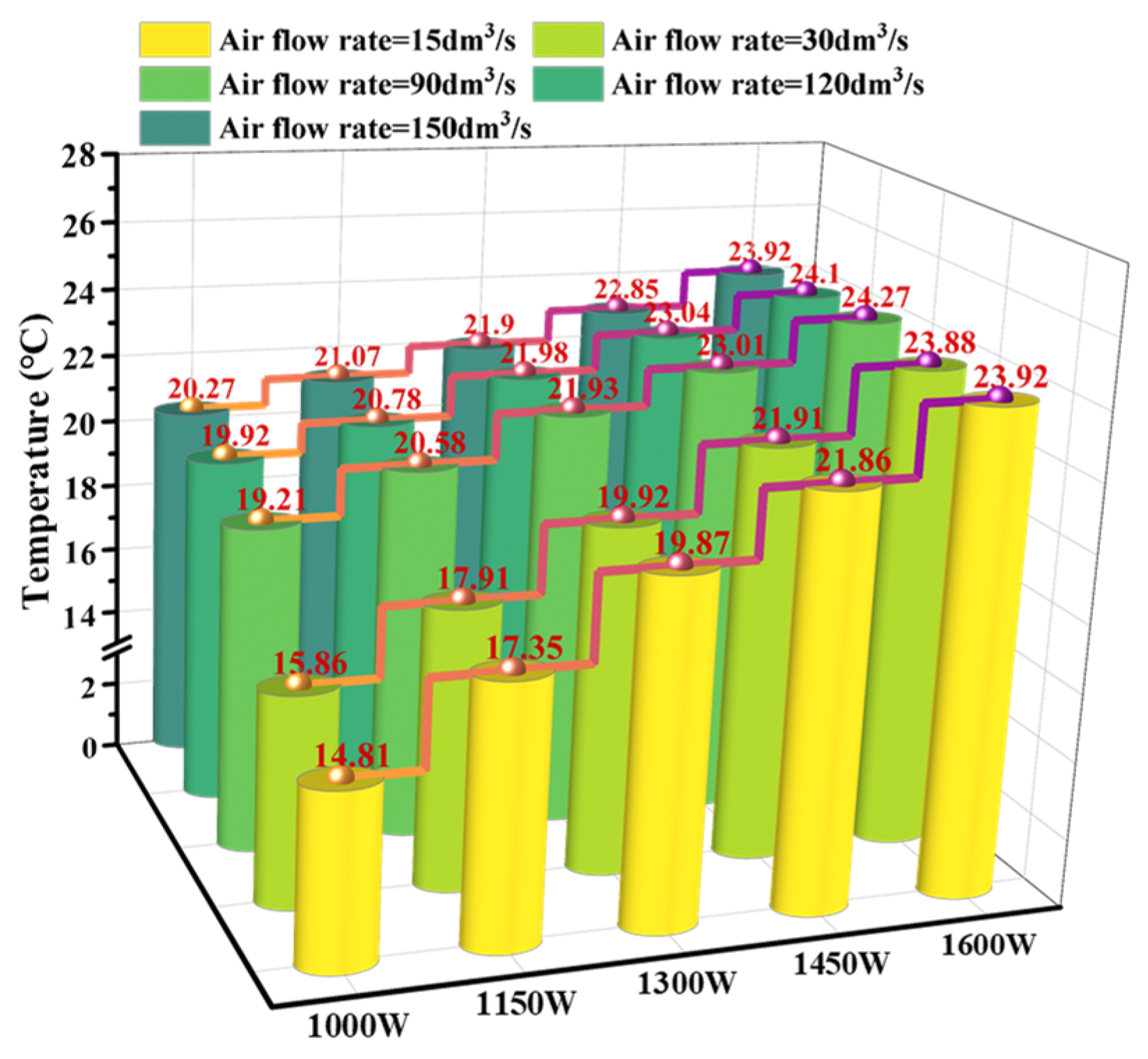

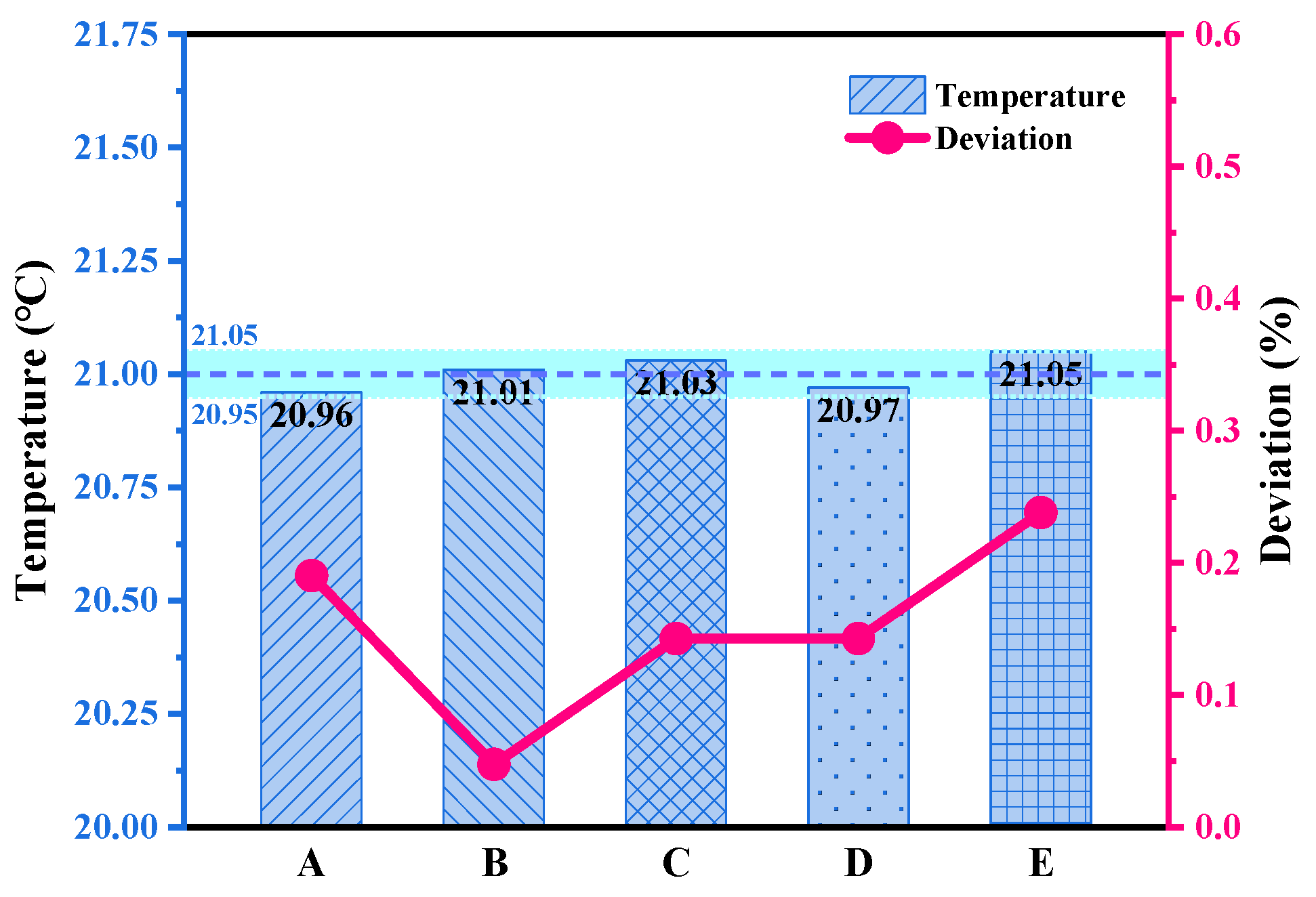
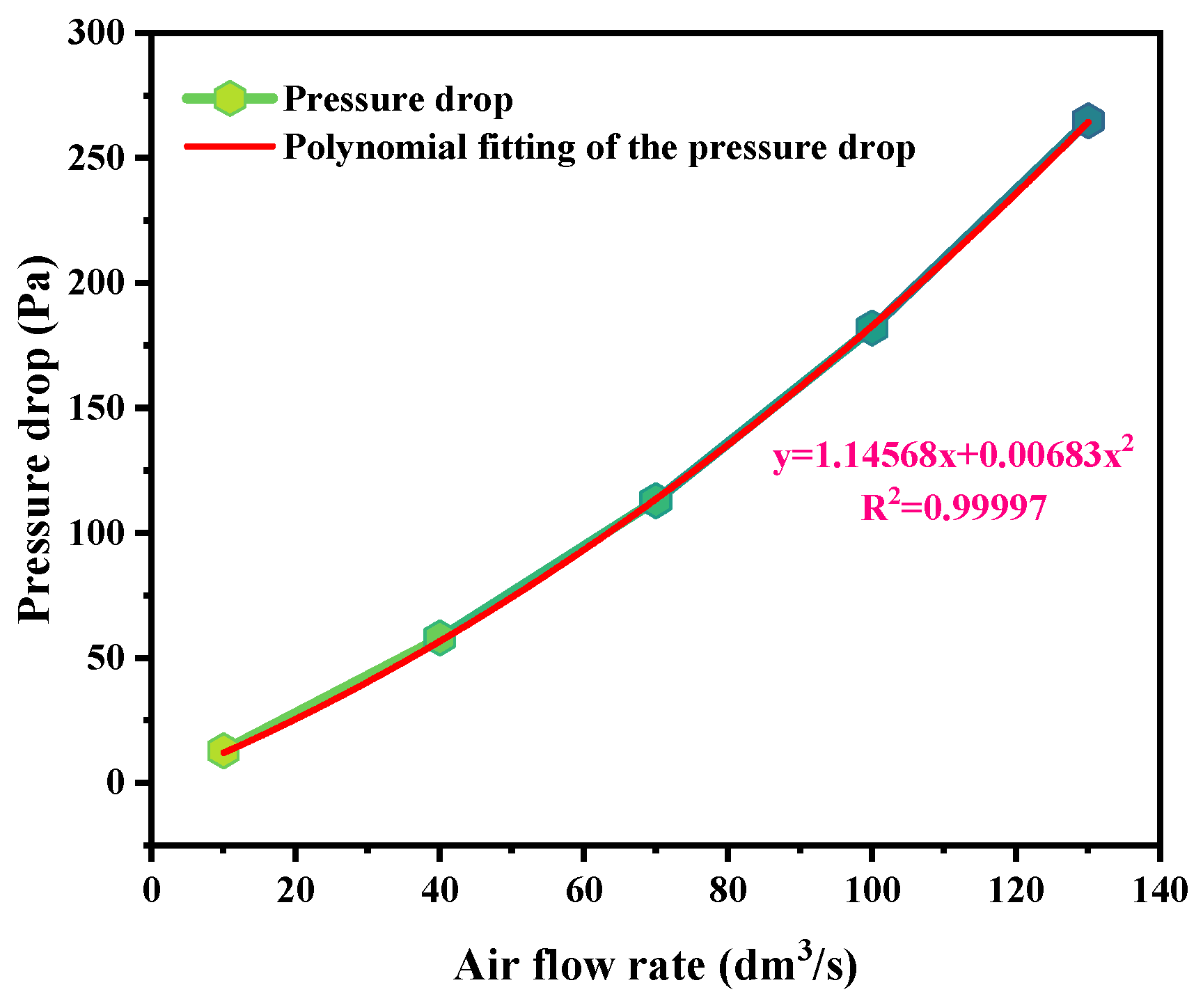
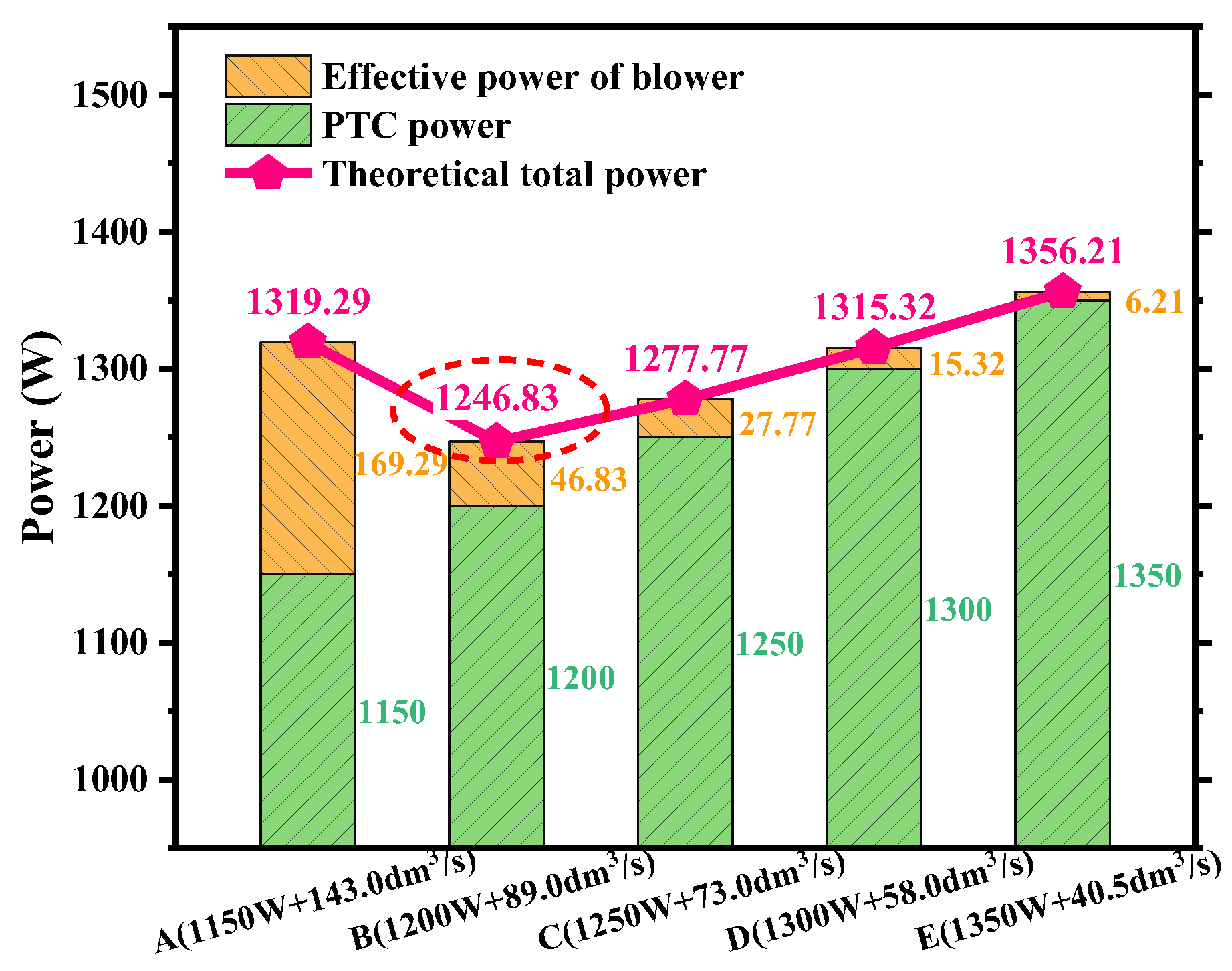

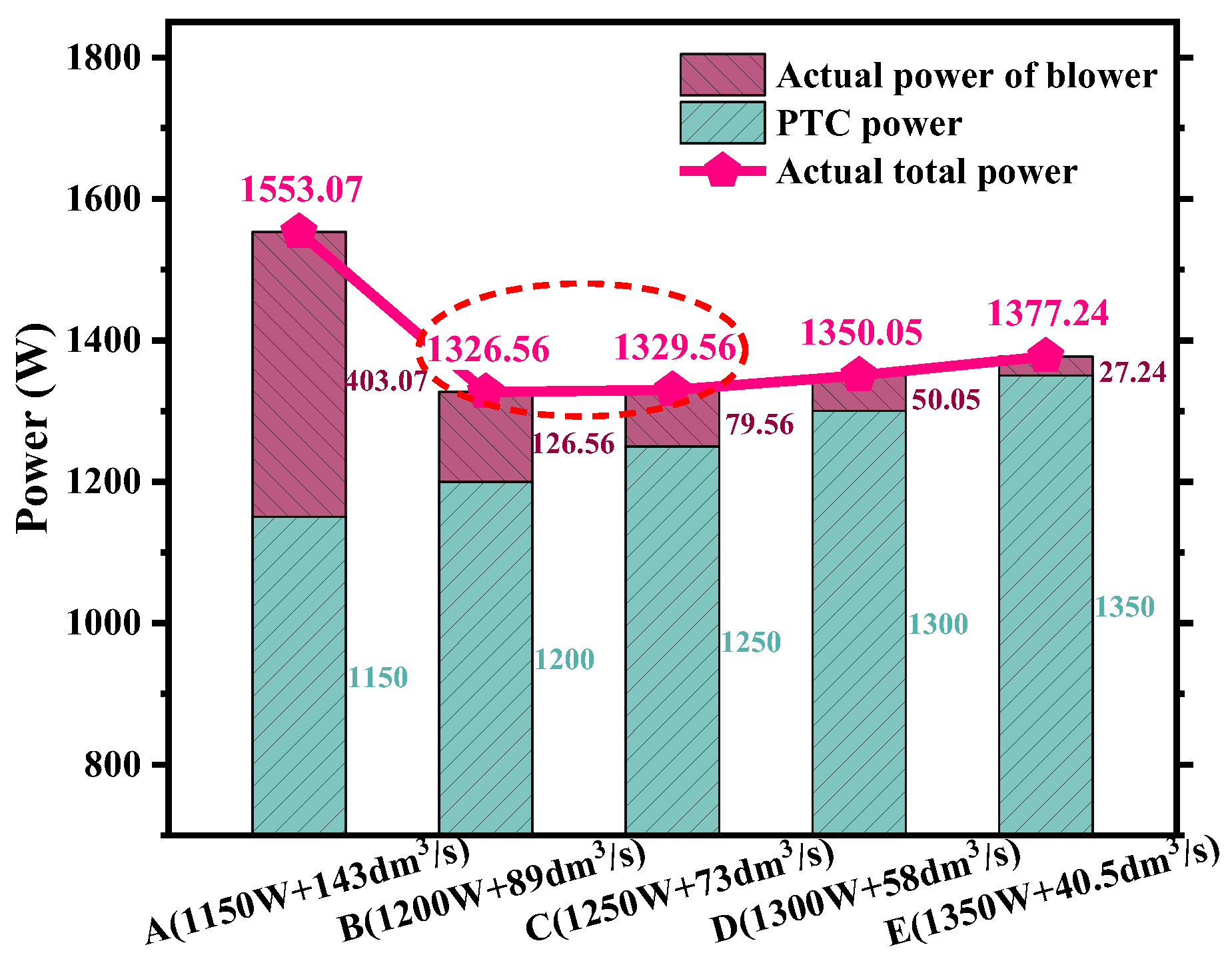
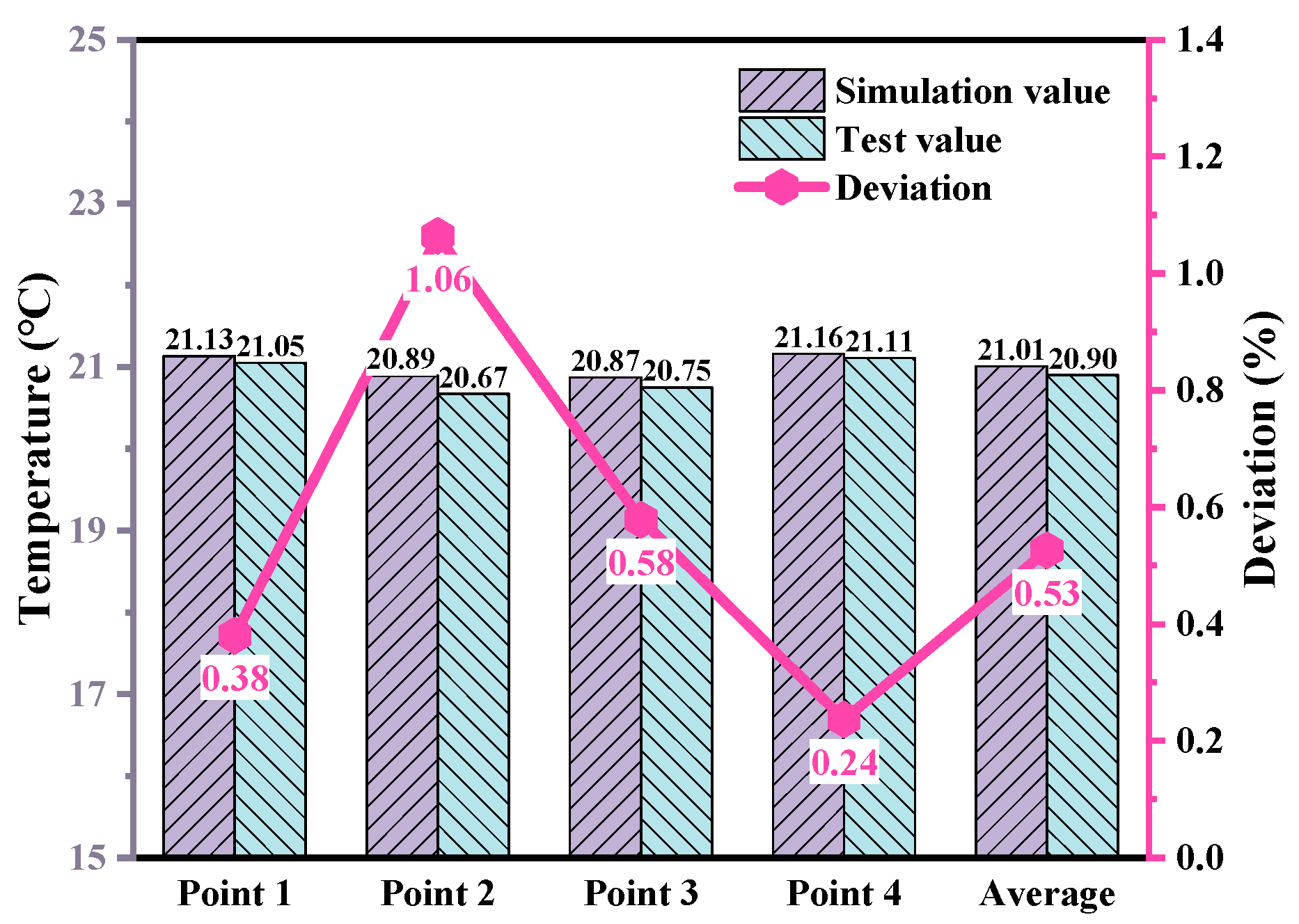
| Parameter | Value | Parameter | Value |
|---|---|---|---|
| Dimensions of the climatic chamber | 16 m × 7.5 m × 5.5 m | Humidity deviation | <5% RH |
| Temperature range | −40 °C~+60 °C | Number of axes on the chassis dynamometer | 2 |
| Temperature deviation | <0.5 °C | Maximum speed | 200 km/h |
| Temperature uniformity * | ≤1 °C | Maximum vehicle weight | 6000 kg |
| Humidity range | 10~90% RH | Power density of the sunlight simulation system | 300~1200 W/m2 |
| Working Condition | PTC Power (W) | Airflow Rate (dm3/s) | Working Condition | PTC Power (W) | Airflow Rate (dm3/s) | Working Condition | PTC Power (W) | Airflow Rate (dm3/s) |
|---|---|---|---|---|---|---|---|---|
| 1-1 | 1000 | 15 | 3-1 | 1300 | 15 | 5-1 | 1600 | 15 |
| 1-2 | 30 | 3-2 | 30 | 5-2 | 30 | |||
| 1-3 | 60 | 3-3 | 60 | 5-3 | 60 | |||
| 1-4 | 90 | 3-4 | 90 | 5-4 | 90 | |||
| 1-5 | 120 | 3-5 | 120 | 5-5 | 120 | |||
| 1-6 | 150 | 3-6 | 150 | 5-6 | 150 | |||
| 2-1 | 1150 | 15 | 4-1 | 1450 | 15 | - | ||
| 2-2 | 30 | 4-2 | 30 | |||||
| 2-3 | 60 | 4-3 | 60 | |||||
| 2-4 | 90 | 4-4 | 90 | |||||
| 2-5 | 120 | 4-5 | 120 | |||||
| 2-6 | 150 | 4-6 | 150 | |||||
| Working Condition | Temperature (°C) | Working Condition | Temperature (°C) | ||||||||
|---|---|---|---|---|---|---|---|---|---|---|---|
| Point 1 | Point 2 | Point 3 | Point 4 | Average | Point 1 | Point 2 | Point 3 | Point 4 | Average | ||
| 1-1 | 14.92 | 14.72 | 14.71 | 14.88 | 14.81 | 3-4 | 21.99 | 21.84 | 21.86 | 22.03 | 21.93 |
| 1-2 | 15.97 | 15.68 | 15.77 | 16.02 | 15.86 | 3-5 | 22.09 | 21.86 | 21.91 | 22.06 | 21.98 |
| 1-3 | 17.49 | 17.32 | 17.41 | 17.51 | 17.43 | 3-6 | 22.02 | 21.77 | 21.83 | 21.98 | 21.90 |
| 1-4 | 19.40 | 18.96 | 19.08 | 19.39 | 19.21 | 4-1 | 21.98 | 21.67 | 21.75 | 22.02 | 21.86 |
| 1-5 | 20.09 | 19.74 | 19.84 | 20.01 | 19.92 | 4-2 | 22.22 | 21.70 | 21.68 | 22.04 | 21.91 |
| 1-6 | 20.34 | 20.21 | 20.22 | 20.31 | 20.27 | 4-3 | 23.01 | 22.76 | 22.72 | 22.99 | 22.87 |
| 2-1 | 17.42 | 17.27 | 17.27 | 17.44 | 17.35 | 4-4 | 23.22 | 22.89 | 22.70 | 23.23 | 23.01 |
| 2-2 | 17.97 | 17.82 | 17.86 | 17.99 | 17.91 | 4-5 | 23.19 | 22.97 | 22.87 | 23.13 | 23.04 |
| 2-3 | 19.35 | 19.23 | 19.14 | 19.31 | 19.26 | 4-6 | 22.94 | 22.77 | 22.77 | 22.92 | 22.85 |
| 2-4 | 20.64 | 20.51 | 20.56 | 20.61 | 20.58 | 5-1 | 24.00 | 23.88 | 23.83 | 23.96 | 23.92 |
| 2-5 | 20.93 | 20.67 | 20.63 | 20.89 | 20.78 | 5-2 | 24.05 | 23.75 | 23.68 | 24.04 | 23.88 |
| 2-6 | 21.22 | 21.02 | 20.93 | 21.12 | 21.07 | 5-3 | 24.41 | 24.09 | 23.87 | 24.27 | 24.16 |
| 3-1 | 20.01 | 19.75 | 19.80 | 19.93 | 19.87 | 5-4 | 24.41 | 24.21 | 24.08 | 24.36 | 24.27 |
| 3-2 | 20.05 | 19.76 | 19.83 | 20.04 | 19.92 | 5-5 | 24.26 | 23.99 | 23.96 | 24.19 | 24.10 |
| 3-3 | 21.23 | 20.87 | 20.95 | 21.29 | 21.09 | 5-6 | 24.10 | 23.80 | 23.77 | 24.01 | 23.92 |
| Working Condition | PTC Power (W) | Airflow Rate (dm3/s) | (Pa) | (Pa) | (Pa) | (W) |
|---|---|---|---|---|---|---|
| A | 1150 | 143.0 | 303.50 | 880.34 | 1183.84 | 169.29 |
| B | 1200 | 89.0 | 156.07 | 370.08 | 526.15 | 46.83 |
| C | 1250 | 73.0 | 120.03 | 260.33 | 380.36 | 27.77 |
| D | 1300 | 58.0 | 89.43 | 174.65 | 264.08 | 15.32 |
| E | 1350 | 40.5 | 57.60 | 95.73 | 153.33 | 6.21 |
Disclaimer/Publisher’s Note: The statements, opinions and data contained in all publications are solely those of the individual author(s) and contributor(s) and not of MDPI and/or the editor(s). MDPI and/or the editor(s) disclaim responsibility for any injury to people or property resulting from any ideas, methods, instructions or products referred to in the content. |
© 2024 by the authors. Licensee MDPI, Basel, Switzerland. This article is an open access article distributed under the terms and conditions of the Creative Commons Attribution (CC BY) license (https://creativecommons.org/licenses/by/4.0/).
Share and Cite
Zhang, D.; Ni, J.; Shi, X. Study of Low-Temperature Energy Consumption Optimization of Battery Electric Vehicle Air Conditioning Systems Considering Blower Efficiency. Processes 2024, 12, 1495. https://doi.org/10.3390/pr12071495
Zhang D, Ni J, Shi X. Study of Low-Temperature Energy Consumption Optimization of Battery Electric Vehicle Air Conditioning Systems Considering Blower Efficiency. Processes. 2024; 12(7):1495. https://doi.org/10.3390/pr12071495
Chicago/Turabian StyleZhang, Dezheng, Jimin Ni, and Xiuyong Shi. 2024. "Study of Low-Temperature Energy Consumption Optimization of Battery Electric Vehicle Air Conditioning Systems Considering Blower Efficiency" Processes 12, no. 7: 1495. https://doi.org/10.3390/pr12071495





